“Just grab something quick!”
That phrase echoes in homes, offices, schools—and gas stations—across the world. But how did “quick” become a plastic-wrapped snack with a 2-year shelf life? How did brightly colored boxes and frozen meals slowly replace our grandmother’s steaming plates of fresh food?
When Maya was a child in the late 1980s, grocery shopping was a family ritual. Her mother would inspect fruits, pick out greens from local vendors, and walk home with canvas bags full of fresh ingredients. Meals were cooked from scratch. Snacks were seasonal fruits or roasted nuts. Fast forward to today—Maya’s own children snack on chips between online classes and eat microwave dinners while she juggles work emails.
This isn’t just her story. It’s our story. The transformation of our food landscape over the past four decades has quietly reshaped how we eat, live—and gain weight.
It wasn’t always like this. Let’s rewind.
The Beginning: A Nation in a Hurry
In the early 20th century, industrialization transformed not just our cities—but our kitchens.
It started innocently enough: with refrigeration, mass production, and clever marketing. In post-World War II America, food companies saw an opportunity to provide “modern solutions” to busy households. Canned soups, frozen dinners, and boxed cereals exploded onto the scene.
World Wars I and II introduced canned goods and processed rations to millions of soldiers. When they came home, convenience had a taste. And it tasted like preserved meats, powdered soups, and canned beans.
Then came the 1950s boom—suburbs, cars, televisions, and the rise of two-income households. With less time to cook, families turned to the new wonder of TV dinners. For the first time, food wasn’t cooked with love—it was heated with haste.
Marketing Magic: From Shelf to Soul
By the 1970s and 80s, food corporations had a new weapon: advertising.
They didn’t sell food. They sold emotions.
“Open happiness.”
“They’re gr-r-reat!”
“I’m lovin’ it.”
Supermarkets expanded. Shelves were lined with boxes, wrappers, and promises—“Low Fat,” “Sugar-Free,” “Now with Extra Cheese.” What they didn’t tell you? Many of these were ultra-processed, loaded with additives, sugar, and salt to hijack your taste buds.
And let’s not forget the child-focused branding: bright cartoon mascots, surprise toys in cereal boxes, and catchy jingles. Children grew up associating processed foods with fun, comfort, and reward.
And we loved it.
Hyperpalatability and the Science of Addiction
Packaged food isn’t just convenient—it’s engineered.
Scientists in food labs have mastered the “bliss point”—the perfect combination of sugar, salt, and fat that makes your brain scream for more. You’re not weak. You’re outnumbered by algorithms trained to override your hunger cues.
Take potato chips. Ever noticed how you can’t stop at one? That’s not willpower. That’s design.
The Sedentary Shift
As processed foods became staples, our lives became more still. Work moved from fields and factories to cubicles and screens. Kids who once biked and played outside now scroll and snack.
Our calorie intake increased, but our output plummeted.
And the scales tipped.
Obesity: The Epidemic We Didn’t See Coming
Today, over 1 billion people around the globe are obese. In countries like the U.S., more than 40% of adults live with obesity. And the numbers keep rising.
Let’s be clear: obesity isn’t just about willpower. It’s about an environment that constantly promotes high-calorie, low-nutrition food—and makes healthy choices hard.
We’re surrounded by:
- Vending machines, not fruit baskets
- Energy drinks, not water coolers
- Meal deals, not mindful meals
Here’s how packaged food drives obesity:
Addictive Flavor Engineering
Additives like MSG and high-fructose corn syrup stimulate dopamine pathways—mimicking addiction-like responses.
Excess Calories, Minimal Nutrition
A single pack of instant noodles may deliver over 400 calories with almost no vitamins or fiber.
Portion Distortion
Packaged snacks are sold in oversized servings—chips, sugary drinks, and frozen pizzas—all encouraging overconsumption.
Loss of Satiety Signals
Processed ingredients alter how our bodies regulate hunger. You eat more but stay unsatisfied.
Aggressive Marketing = Early Exposure
Studies show that children exposed to junk food advertising develop lifelong cravings for high-calorie processed products.
A Way Forward: From Processed to Purposeful
The answer isn’t demonizing all packaged food—but rethinking our relationship with it.
Here’s how we can start:
- Read labels: Less than five ingredients? That’s a good sign.
- Cook more: Home-cooked meals give you control.
- Be mindful: Eat without screens, slow down, feel full.
- Choose whole foods: Apples, lentils, oats—things without mascots.
Food Access Equity: Supporting local markets, urban farming, and community kitchens helps shift dependence from packaged to fresh.
Final Thought: Convenience Has a Cost
Packaged food crept into our lives as a helper. But somewhere along the way, it became a habit—then a health hazard.
Now, we’re paying the price in rising obesity rates, diabetes, heart disease, and mental fatigue.
But awareness is powerful. The moment you see the pattern—you can start breaking it.
So, next time you reach for something fast, ask:
“Is this food feeding me—or fooling me?”




One thought on “How Packaged Food Caused the Obesity Epidemic”